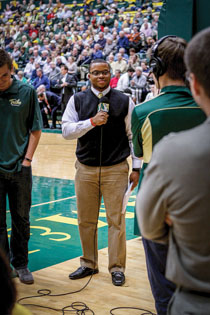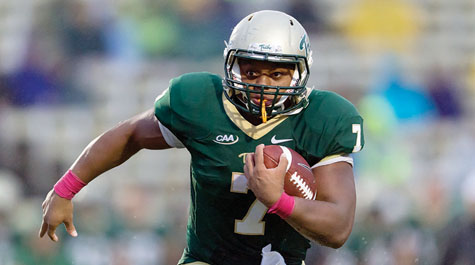Mikal Abdul-Saboor '16 is the face of Tribe broadcasting
This story originally appeared in the spring 2015 issue of the W&M Alumni Magazine. - Ed.
Go to any Tribe football game, and you’ll know Mikal Abdul-Saboor ’16 doesn’t spend much time on the sidelines. Last season, on the way to earning all-conference honors, the running back led the Colonial Athletic Association and ranked 13th nationally, with 115.1 rushing yards per game. He rushed for a season-total 1,266 yards, the sixth-best in school history, and he became just the second Tribe player to eclipse the 1,000-yard rushing mark in the last 16 seasons.
But this winter, he WAS on the sidelines — of the basketball court. During the past season, Abdul-Saboor served as the face of Tribe broadcasts during men’s and women’s basketball games at Kaplan Arena. The broadcasts were the independent study for Abdul-Saboor’s self-created major, sports in society.
So how did a football player end up doing sideline reporting during a basketball broadcast? It’s kind of like how a high school quarterback from Georgia ended up as a star running back for the Tribe — he took the opportunity and then worked his butt off.
At Alpharetta High School, Abdul-Saboor was a three-year letter winner as a quarterback, earning honorable mention all-state honors his senior year. When the Tribe’s offensive line coach came to his high school, Abdul-Saboor had never even heard of William & Mary. But after doing some research, he found it was a natural fit. The academic excellence appealed not only to him, but to his parents, and after coming to visit, he found the atmosphere at the College to be friendly and welcoming.
And William & Mary was one of the only schools that offered him the opportunity to play quarterback. Abdul-Saboor served as scout team quarterback his freshman year, but then his coaches thought he could help the team at the running back position.
“I was upset initially because that’s the whole reason I came — for the opportunity to play quarterback,” Abdul-Saboor said. But he took the chance. And it turned out not to be a huge leap. As a quarterback in high school, he had rushed for 1,062 yards his senior year — he was already essentially a running back throwing the ball.
Abdul-Saboor’s redshirt freshman year was not the one he wanted. But he learned from it. “Initially I thought, OK, I’m going to play running back, so just run,” he said. “But there’s a lot more to it.”
 By watching film, Abdul-Saboor was able to learn how to have patience, make cuts and set up blocks. He also spent more time in the weight room to get stronger. As a high school quarterback, he had never lifted heavily because he was worried about shoulder injuries, but now he had to build up his strength to be on par with other running backs in the league.
By watching film, Abdul-Saboor was able to learn how to have patience, make cuts and set up blocks. He also spent more time in the weight room to get stronger. As a high school quarterback, he had never lifted heavily because he was worried about shoulder injuries, but now he had to build up his strength to be on par with other running backs in the league.
The hard work paid off his sophomore year, when he posted 100-yard rushing performances in six of the nine games he played, and finished the season third in the CAA in rushing yards per game.
“I think my greatest strength is my vision,” Abdul-Saboor said. “I always had to know what the defense was doing because you have to scout the defense as a quarterback. Other positions might just scout the positions that are guarding them, but as quarterback you scout the entire defense. Coming to the running back position, I already knew how to look at an entire defense and predict what they are going to do; I naturally had that vision. So sometimes I can see some cuts that other guys might not be able to see.”
Off the field, Abdul-Saboor is a sports in society major, a major that he created. It’s modeled after the marketing and management concentrations, but then also touches on aspects of communications, sociology and kinesiology. In the fall semester of 2014, Abdul-Saboor was taking a television in sports class, taught by the former president of ABC Sports Jim Spence. One day Pete Clawson, senior assistant athletic director of public relations, came into the class and talked about new TV productions for Tribe Athletics and how the department wanted to incorporate students into the broadcasts.
Most majors have an honors thesis or internship, but because Abdul-Saboor’s major is self-created, he thought these broadcasts would be a good way for him to do something hands-on and get some field experience. With the help of Spence, Clawson and Abdul-Saboor’s adviser, Todd Mooradian, he was able to use the basketball broadcasts as an independent study, something he’s learned a lot from.
“I have a lot of respect for analysts and commentators that I didn’t have before because it is very difficult,” he said.
The first time Abdul-Saboor interviewed someone on camera, the production team set him up. Going up to the women’s basketball coach after a tough defeat, Abdul-Saboor asked head coach Ed Swanson how he felt about the loss.
“That’s a terrible question!” Swanson yelled. “What kind of question is that?”
Abdul-Saboor usually gets a schedule for his broadcasts a day or two before, listing every time he’ll be on camera. To prepare, he’ll come up with questions for the interviews he knows he’ll be doing. The broadcasts usually feature a pregame interview with the coach, a feature about halfway through the first half (a past interview included baseball players talking about the upcoming season), a reading of upcoming events in Tribe Athletics, as well a short analysis of the game towards the end of the first half. Half-time includes another feature interview (a recent one was done with his own coach, Jimmye Laycock ’70), and during the second half he does another analysis of what’s going on in the game. Postgame video includes another coach’s interview.
While he can create some questions beforehand, Abdul-Saboor generates the analysis pieces during the game by looking at the stats on his iPad or going and listening behind the bench during timeouts to see what the coaches are saying to the team.
Abdul-Saboor is used to being under pressure, but sometimes the nerves still get to him. “Sometimes I’ll be shaking,” he said. “But once I get up and the mic is plugged in and I know I’m about to be counted down, it all goes away. It’s kind of like football — I’m usually nervous before every football game until the first play. It’s all released once I start playing.”
What does he like most about doing the broadcasts? “To be completely honest, I’d say the courtside seats,” he said. “Most students are either in the student section or up top. I get to sit on the court for all the games.” But Abdul-Saboor also likes interacting with people, whether it’s the coaches and athletes he interviews, or the production crew.
Abdul-Saboor is enjoying the ride, even though he’s not sure he wants to pursue a career in broadcasting. “I was really looking into this just as an independent study. I think anybody, if the opportunity presented itself, would do something like this. I’m not sure if I want to do this for my career, but I’m not going to say I wouldn’t try if it wasn’t presented to me.”
Abdul-Saboor plans on pursuing professional football after graduation, and if that doesn’t work out, he’ll start in William & Mary’s Flex M.B.A. program and finish up his M.B.A. by serving as a graduate assistant for a football program.
“My dream job is working in a front office for a professional sports team in the NBA or NFL. I ultimately want to be a GM. I know it’s a long road to get there, but hey, you never know. If I meet some of the right people, perform well in my duties, nothing is impossible.”















